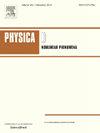On a high-order shallow-water wave model with canonical non-local Hamiltonian structure
IF 2.9
3区 数学
Q1 MATHEMATICS, APPLIED
引用次数: 0
Abstract
We derive and study a new family of non-local partial differential equations (PDEs) that model free-surface long gravity waves over a flat bottom. To derive the model equations we approximate the velocity potential as a series of vertical polynomials derived from the shallow-water expansion of the Dirichlet-to-Neumann problem in the Hamiltonian formulation of free-surface potential flow and invoke Luke’s variational principle. The resulting evolution equations exhibit a non-local Hamiltonian structure being coupled with a system of linear elliptic spatial PDEs on the horizontal plane. A key advantage of this approach is that it directly yields canonical Hamiltonian equations, which are well-suited for numerical solutions using standard methods. This class of model equations offers high-order shallow-water approximations of the water-wave problem. It contains terms whose spatial derivatives are at most of order two, distinguishing it from asymptotic methods involving higher-order mixed spatio-temporal derivatives. We explore the first non-trivial member of this family, highlighting its connections to other mathematical models and emphasizing its practical utility. We then analyse and discuss its linear dispersive properties and demonstrate that it does not exhibit a specific type of instability known as wave-trough instability. Additionally, we demonstrate its effectiveness in simulating the long-distance steady propagation of strongly non-linear solitary waves and the head-on collision of two counter-propagating solitary waves. In the latter case, comparisons with experimental data confirm the model’s ability to capture complex wave dynamics, including wave transformation in the presence of strong non-linearity and dispersion. The extension of this approach to accommodate variable bottom topography is briefly discussed.
具有正则非局部哈密顿结构的高阶浅水波模型
我们导出并研究了一类新的非局部偏微分方程(PDEs),用于模拟平坦底上的自由表面长重力波。为了推导模型方程,我们将速度势近似为自由表面势流哈密顿公式中Dirichlet-to-Neumann问题的浅水展开式的一系列垂直多项式,并调用卢克变分原理。所得的演化方程表现出非局部哈密顿结构在水平面上与线性椭圆空间偏微分方程系统耦合。这种方法的一个关键优点是它直接产生标准哈密顿方程,它非常适合使用标准方法进行数值解。这类模型方程提供了水波问题的高阶浅水近似。它包含空间导数最多为2阶的项,将其与涉及高阶混合时空导数的渐近方法区分开来。我们探索这个家族的第一个重要成员,强调它与其他数学模型的联系,并强调它的实际用途。然后,我们分析和讨论了它的线性色散特性,并证明它不表现出一种称为波谷不稳定性的特定类型的不稳定性。此外,我们还证明了它在模拟强非线性孤立波的长距离稳定传播和两个反向传播孤立波的正面碰撞方面的有效性。在后一种情况下,与实验数据的比较证实了该模型能够捕捉复杂的波动动力学,包括在存在强非线性和色散的情况下的波动变换。简要讨论了这种方法的扩展,以适应变化的底部地形。
本文章由计算机程序翻译,如有差异,请以英文原文为准。
求助全文
约1分钟内获得全文
求助全文
来源期刊

Physica D: Nonlinear Phenomena
物理-物理:数学物理
CiteScore
7.30
自引率
7.50%
发文量
213
审稿时长
65 days
期刊介绍:
Physica D (Nonlinear Phenomena) publishes research and review articles reporting on experimental and theoretical works, techniques and ideas that advance the understanding of nonlinear phenomena. Topics encompass wave motion in physical, chemical and biological systems; physical or biological phenomena governed by nonlinear field equations, including hydrodynamics and turbulence; pattern formation and cooperative phenomena; instability, bifurcations, chaos, and space-time disorder; integrable/Hamiltonian systems; asymptotic analysis and, more generally, mathematical methods for nonlinear systems.
 求助内容:
求助内容: 应助结果提醒方式:
应助结果提醒方式:


